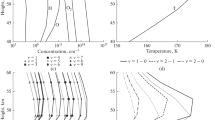Abstract
The rotational temperatures of hydroxyl molecules with different vibrational excitation, which were used to determine the seasonal variations in the vertical temperature distribution near the mesopause at altitudes of 85–90 km, have been obtained based on the spectral measurements of the atmospheric nightglow at IFA RAN observatory in Zvenigorod. The obtained characteristics of the annual and semiannual harmonics have been compared with their lidar and satellite measurements and model representations.
Similar content being viewed by others
References
G. B. Burns, W. J. R. Jrench, P. A. Greet, et al., “Seasonal Variations and Inter-Year Trends in 7 Years of Hydroxyl Airglow Rotational Temperatures at Davis Station (69° S, 78° E), Antarctica,” J. Atmos. Solar-Terr. Phys. 64(8–11), 1167–1174 (2002).
V. V. Bakanas and V. I. Perminov, “Some Features in the Seasonal Behavior of the Hydroxyl Emission Characteristics,” Geomagn. Aeron. 43(3), 389–396 (2003) [Geomagn. Aeron. 43, 363–369 (2003)].
M. A. Berg and N. N. Shefov, “Hydroxyl Emission with Different Oscillatory Excitation,” Polyarn. Siyaniya Svechenie Nochnogo Neba, No. 10, 19–23 (1963).
Brasseur and S. Solomon, Aeronomy of the Middle Atmosphere (Kluwer Academic Publishers Group, 2005).
G. H. Choi, K. Monson, V. B. Wickwar, and D. Rees, “Seasonal Variations of Temperature near the Mesopause from Fabry-Perot Interferometer Observations of OH Meinel Emissions,” Adv. Space Res. 21(6), 843–846 (1998).
R. T. Clancy, D. W. Rush, and M. T. Callan, “Temperature Minima in the Average Thermal Structure of the Middle Mesosphere (70–80 km) from Analysis of 40- to 92-km SME Global Temperature Profiles,” J. Geophys. Res. 99D, 19 001–19 020 (1994).
B. R. Clemesha, K. Takahashi, and P. P. Batista, “Mesopause Temperatures at 23° S,” J. Geophys. Res. 95D, 7677–7681 (1990).
G. A. Gavrilyeva and P. P. Ammosov, “Near-Mesopause Temperatures Registered over Yakutia,” J. Atmos. Solar-Terr. Phys. 64(8–11), 985–990 (2002).
N. G. Gerasimova and A. V. Yakovleva, “The Set of High-Aperture Spectrographs with Diffraction Gratings,” Prib. Tekh. Eksp., No. 1, 83–86 (1956).
A. V. Kharitonov, E. A. Glushkova, A. N. Knyazeva, N. L. Morozova, V. T. Rebristyi, T. V. Sokodovnikov, V. N. Tereshchenko, and L. D. Frishberg, Spectrometric Standards for Observation of Planets and Comets and Certain Problems of Stellar Spectrophotometry, (Nauka, Alma-Ata, 1972) [in Russian].
G. B. Kistiakowsky and F. D. Tabbutt, “Gaseous Detonations. XII. Rotational Temperatures of the Hydroxyl Free Radicals,” J. Chem. Phys. 30(2), 577–581 (1959).
V. I. Krassovsky, B. P. Potapov, A. I. Semenov, M. V. Shagaev, N. N. Shefov, and V. G. Sobolev, “On the Equilibrium Nature of the Rotational Temperature of Hydroxyl Airglow,” Planet. Space Sci. 25(6), 596–597 (1977).
S. R. Langhoff, H. J. Werner, and P. Rosmus, “Theoretical Transition Probabilities for the OH Meinel System,” J. Mol. Spectrosc. 118(4), 507–529 (1986).
J. J. Lopez-Moreno, R. Rodrigo, F. Moreno, et al., “Altitude Distribution of Vibrationally Excited States of Atmospheric Hydroxyl at Levels v = 2 to v = 7,” Planet. Space Sci. 35(8), 1029–1038 (1987).
F. J. Mulligan, D. F. Horgan, J. G. Galligan, and E. M. Griffin, “Mesopause Temperatures and Integrated Band Brightnesses Calculated from Airglow OH Emissions Recorded at Maynooth (53.2° N, 6.4° W) during 1993,” J. Atmos. Solar-Terr. Phys. 57(13), 1623–1637 (1995).
R. J. Niciejewski and T. L. Killeen, “Annual and Semi-Annual Temperature Oscillations in the Upper Mesosphere,” Geophys. Res. Lett. 22(23), 3243–3246 (1995).
D. Offermann and R. Gerndt, “Upper Atmosphere Temperatures from OH*-Emissions,” Adv. Space Res. 10(12), 217–221 (1990).
V. I. Perminov, A. I. Semenov, and K. N. Shefov, “Deactivation of the Hydroxyl Molecule Oscillatory States by Atomic and Molecular Oxygen in the Mesopause Region,” Geomagn. Aeron. 38(6), 100–105 (1998) [Geomagn. Aeron. 38, (1998)].
V. I. Perminov, A. I. Semenov, N. N. Shefov, and V. V. Tikhonova, “Estimation of the Seasonal Variations in the Hydroxyl Emitting Layer Height in the Upper Atmosphere,” Geomagn. Aeron. 33(3), 113–120 (1993).
N. N. Pertsev and V. I. Perminov, “Response of the Mesopause Airglow to Solar Activity Inferred from Measurements at Zvenigorod, Russia,” Ann. Geophys. 26(5), 1049–1056 (2008).
J. M. Picone, A. E. Hedin, D. P. Drob, and A. C. Aikin, “NRLMSISE-00 Empirical Model of the Atmosphere: Statistical Comparisons and Scientific Issues,” J. Geophys. Res. 107A, 1468 (2002).
A. I. Semenov and N. N. Shefov, “Empirical Model of Variations in the Hydroxyl Emission,” Geomagn. Aeron. 36(4), 68–85 (1996).
C. Y. She and U. Zhan, “Concept of a Two-Level Mesopause: Support through New Lidar Observations,” J. Geophys. Res. 103D, 5855–5863 (1998).
C. Y. She and R. P. Lowe, “Seasonal Temperature Variations in the Mesopause Region at Midlatitudes: Comparison of Lidar and Hydroxyl Rotational Temperatures Using WINDII/UARS OH Height Profiles,” J. Atmos. Solar-Terr. Phys. 60, 1573–1583 (1998).
N. N. Shefov, A. I. Semenov, and V. Yu. Khomich, Atmospheric Emission as an Indicator of the Structure and Dynamics of the Atmosphere (Geos, Moscow, 2006), [in Russian].
G. G. Sivjee and R.M. Hamwey, “Temperature and Chemistry of the Polar Mesopause OH,” J. Geophys. Res. 92A, 4663–4672 (1987).
J. Taylor, Introduction to the Theory of Errors (Mir, Moscow, 1985).
T. L. Toroshelidze, “Measurements of the O2 and OH Atmospheric Bands in Nightglow,” Astrophys. Space Sci. 215, 11–15 (1994).
J. H. Yee, G. Crowley, R. G. Roble, et al., “Global Simulations and Observations of O(1S), O2(1Σ) and OH Mesospheric Nightglow Emissions,” J. Geophys. Res. 102A, 19949–19968 (1997).
Author information
Authors and Affiliations
Corresponding author
Additional information
Original Russian Text © V.I. Perminov, 2009, published in Geomagnetizm i Aeronomiya, 2009, Vol. 49, No. 6, pp. 835–842.
Rights and permissions
About this article
Cite this article
Perminov, V.I. Seasonal temperature variations near the mesopause according to the hydroxyl emission measurements in Zvenigorod. Geomagn. Aeron. 49, 797–804 (2009). https://doi.org/10.1134/S0016793209060139
Received:
Accepted:
Published:
Issue Date:
DOI: https://doi.org/10.1134/S0016793209060139




